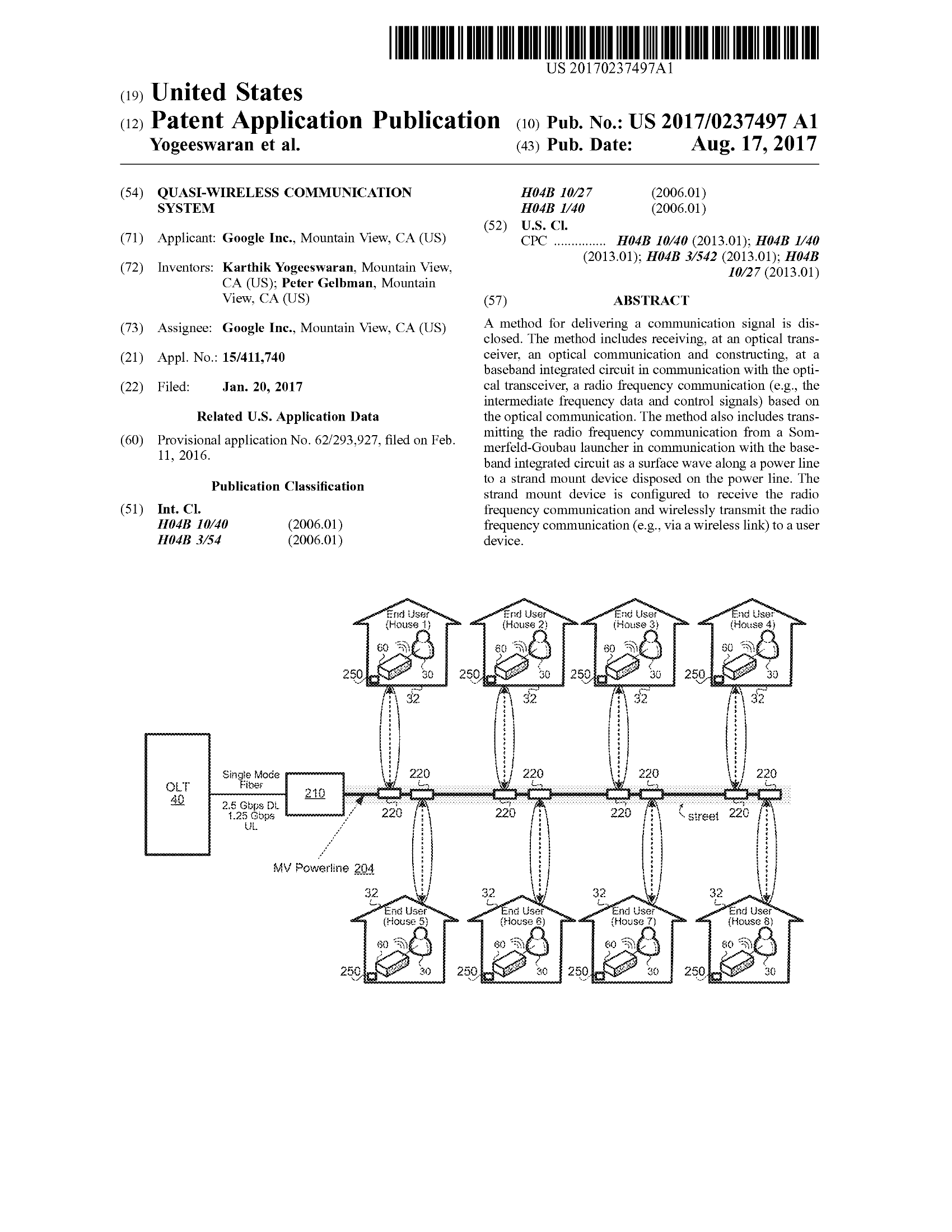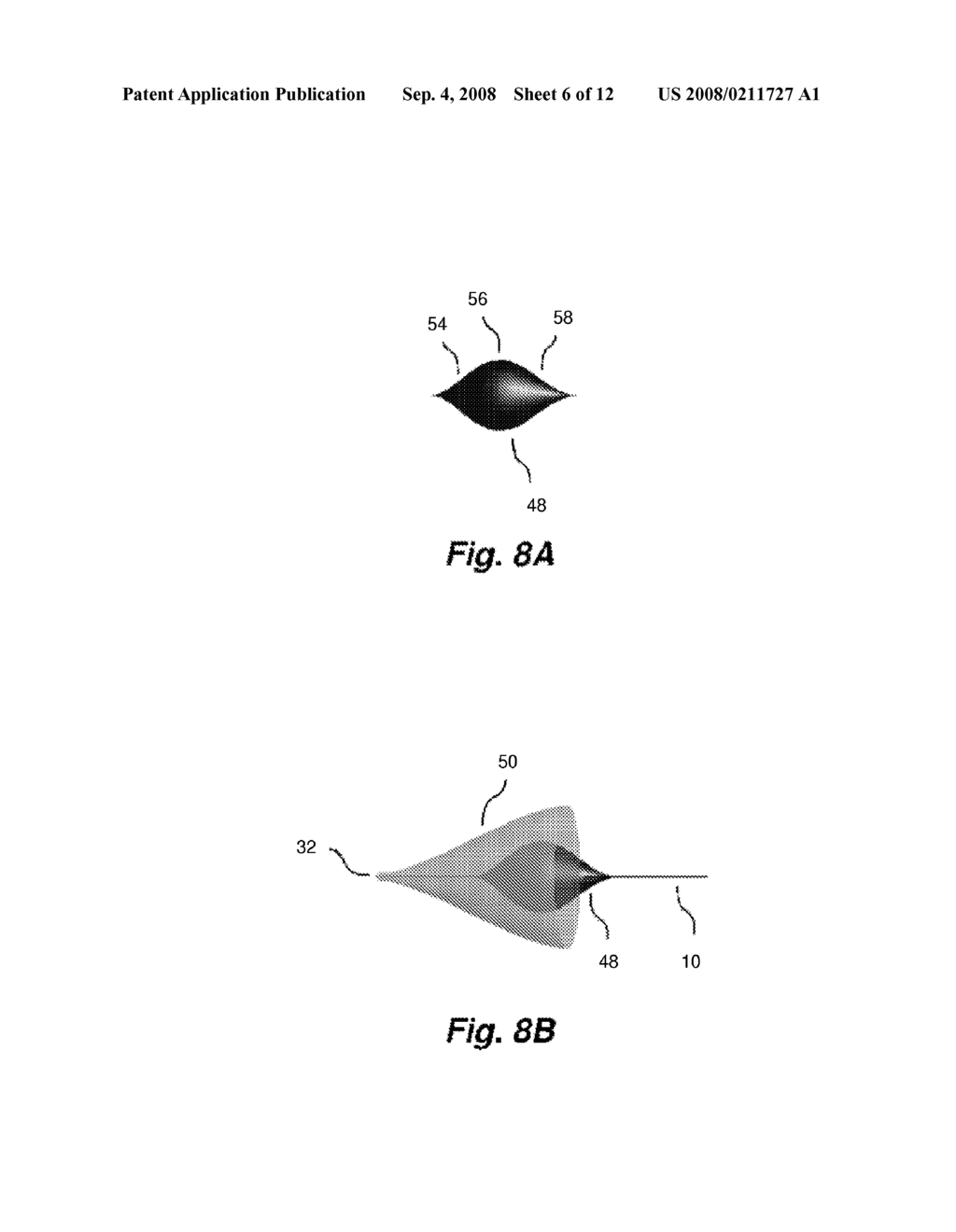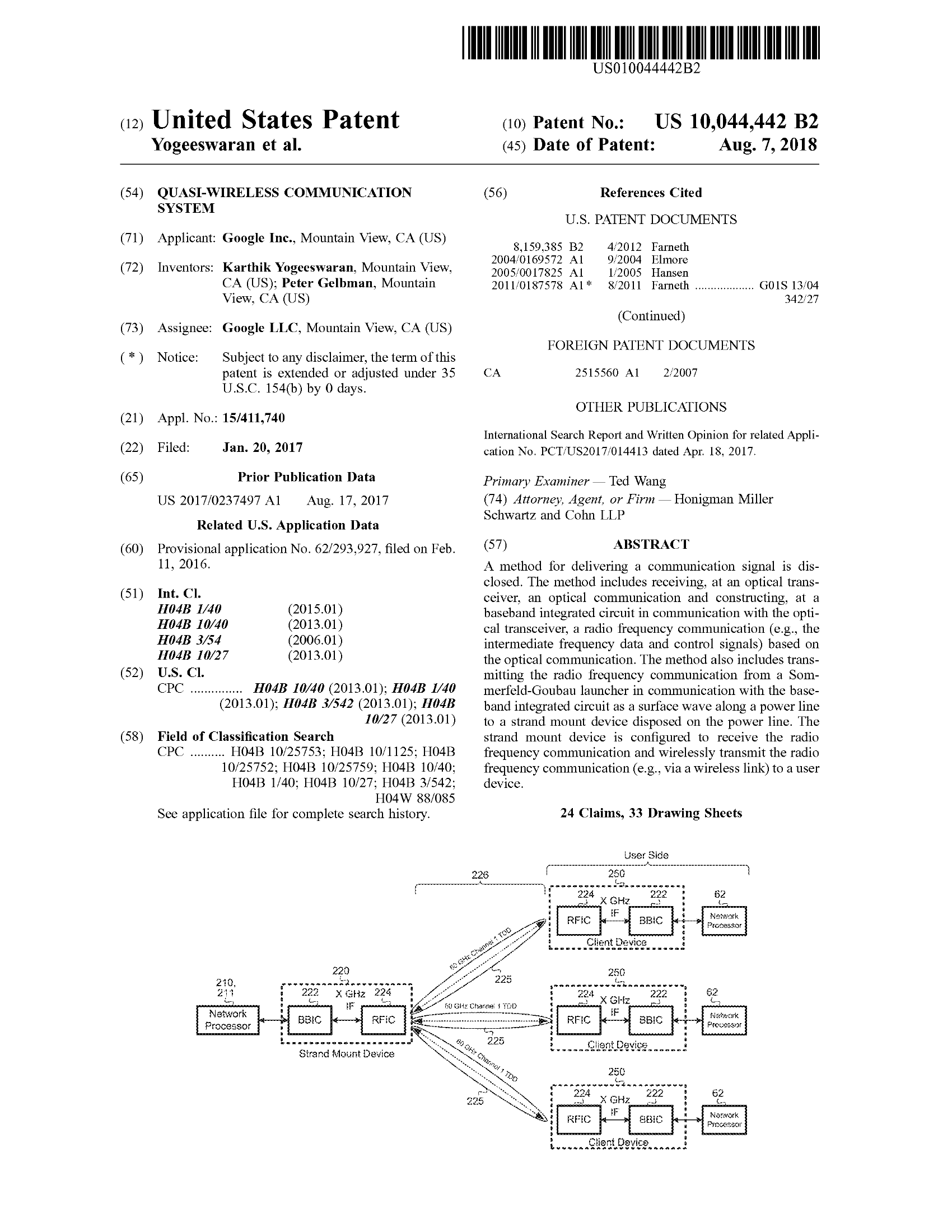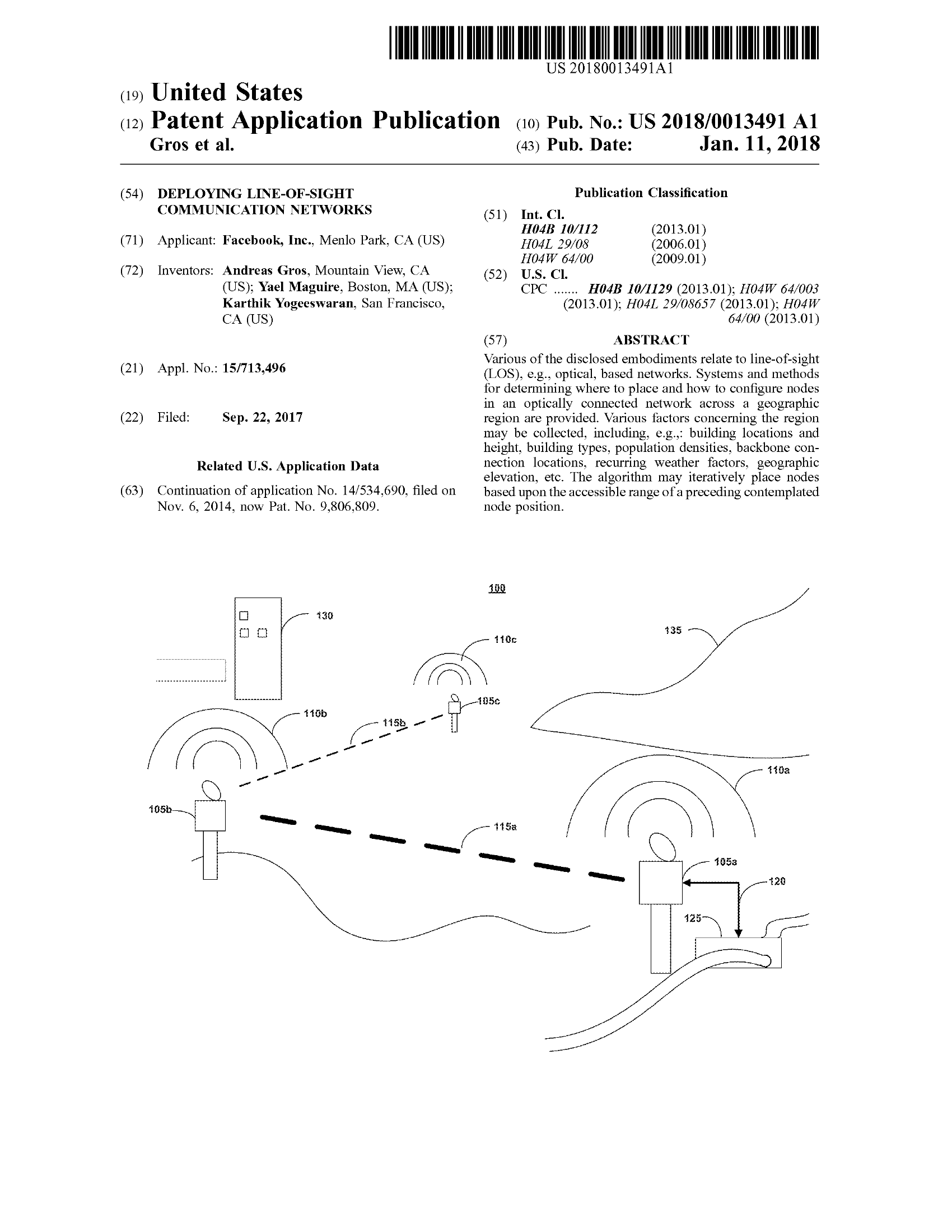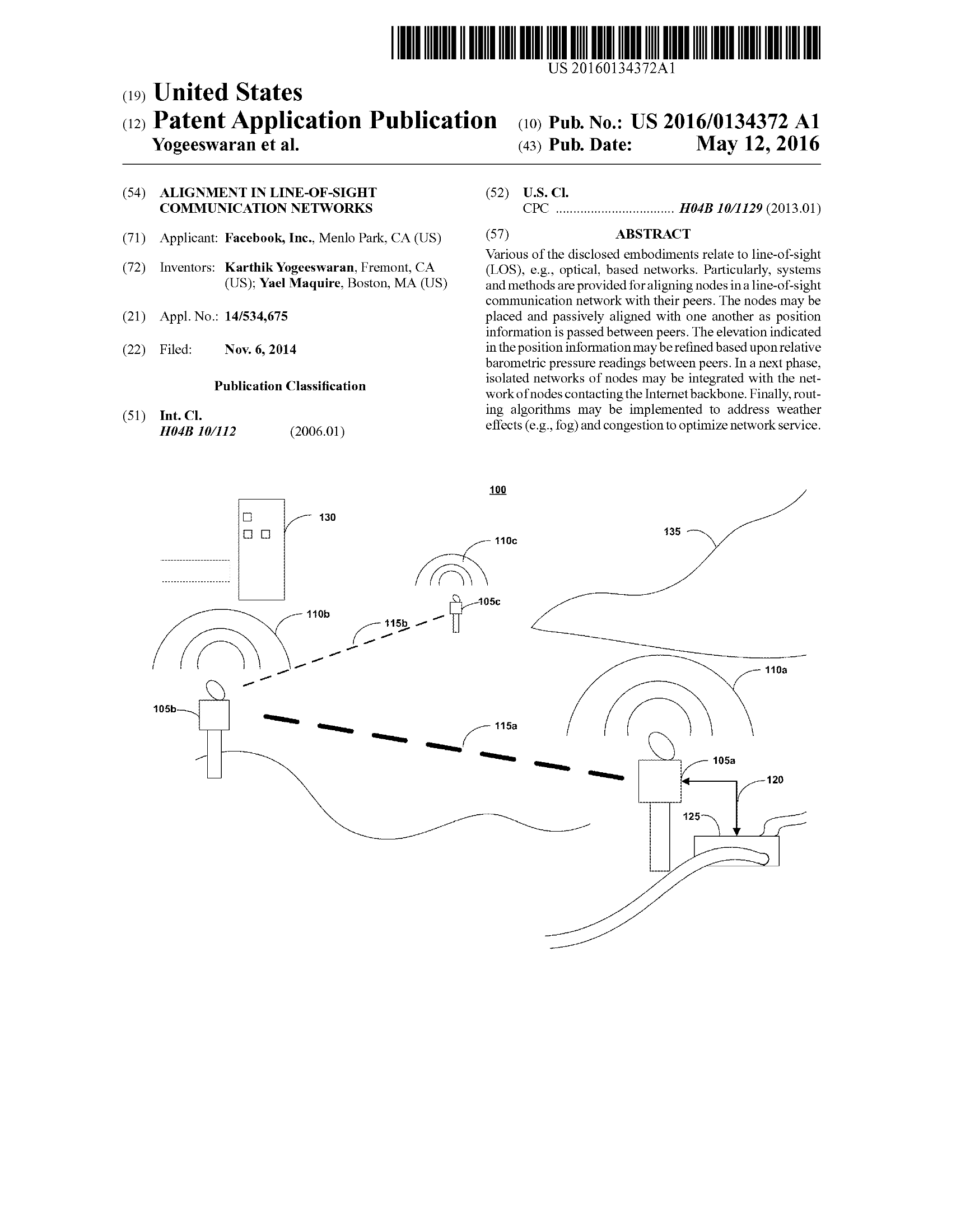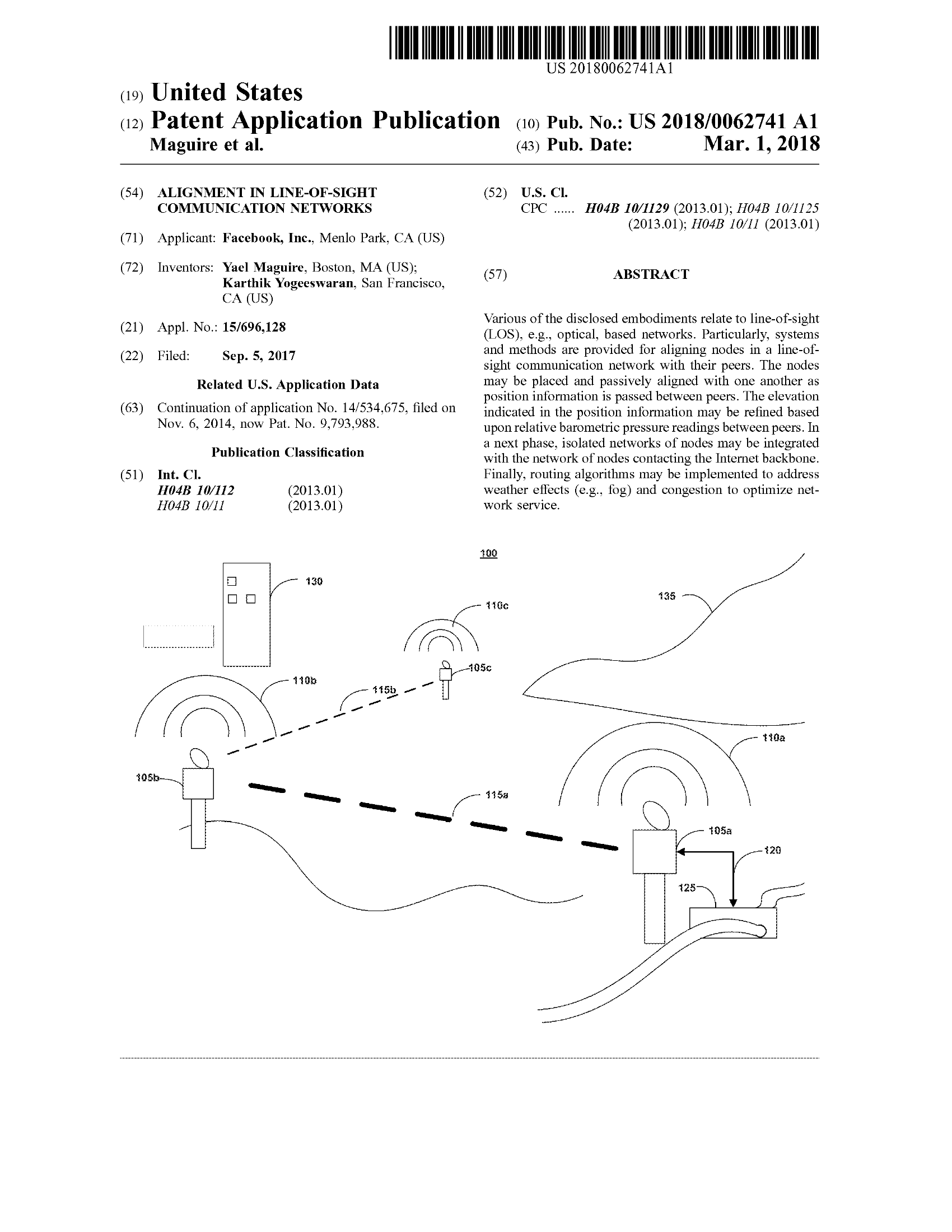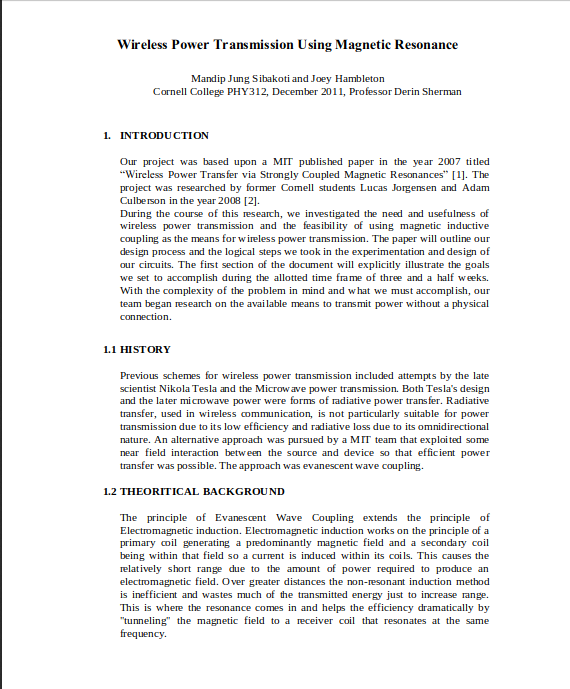Sommerfeld-Goubau is an advancement of the single wire transmission Technology used to conduct radio waves at UHF and Microwave Frequencies developed in the late 1800's to early 1900's.(2,3,4) The dielectric coated transmission line necessary for the intended function, was invented by F. Harms in 1907 and George J. E. Goubau (6) in 1950 (5) based on studies of surface waves on wires by Arnold N. Sommerfeld (7,8), a late 1800's era mathematician, "used as a feed-line at UHF to link high frequency transmitters and receivers to their antennas, and in scientific research." (1) Depicted in Fig.10, "The Goubau line itself consists of a single wire conductor coated with dielectric material.(2) Coupling to and from the G-line is done with conical metal "launchers “or "catchers", with their narrow ends connected for example to the shield of coaxial feed line, and with the transmission line passing through a hole in the conical tips (2) which are used to carry lower frequency radio signals, have high losses at the upper end of the UHF band, and are almost useless for distances over 100 feet (33 meters).(2) Goubau lines can serve as low loss antenna feed-lines at these frequencies, up to microwave frequencies where a wave-guide must be used."(2)
Figure 10
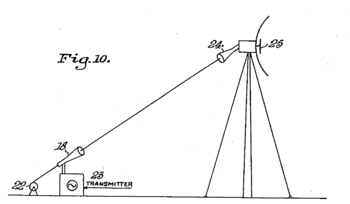
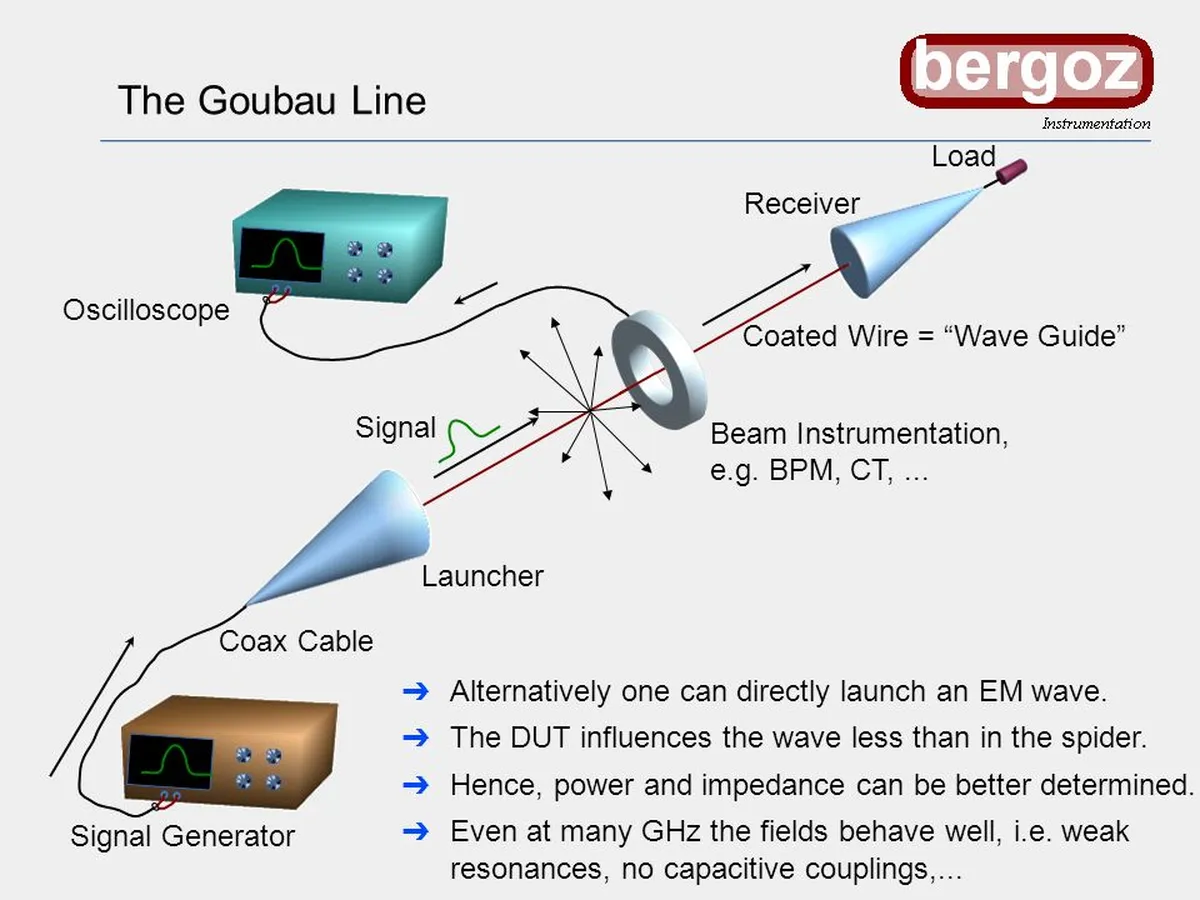
A G-line is a type of waveguide, rather than a wire in an electric circuit. The G-line functions by slowing the propagation velocity of EM waves below the free-space velocity, causing the wave fronts to slightly bend inwards towards the conductor, which keeps the waves entrained. Bends of large radius are tolerated, but too sharp a bend in the single wire will cause the line to radiate and lose energy into space. In theory the dielectric coating is a requirement, it slows the wave and focuses it along the wire. But some users note that in practice the finite conductivity of metals may produce a similar effect, and a bare G-line can entrain a propagating wave. Other structures besides horns have been used to couple radio waves into and out of Goubau lines; waves can be "launched" from planar structures like tapered coplanar waveguides at much higher frequencies, into the terahertz band. The dimension of the single metallic conductor is then typically 1 µm (9). The Goubau line conducts energy via one-dimensional electromagnetic surface waves, analogous to the two-dimensional surface waves called ground waves that carry the signal from MF AM broadcasting stations to home AM radios. The ability of surface waves to bend and follow the contour of a conductor explains why AM radio stations can be received on the far side of hills, and how over-the-horizon radar works.
Nano tech, for this technology, is integral to the system in both internal and external use cases. the Thz frequencies are of the right intensity to breach the skin, allowing transmission to reach potential tech inside of a subject to provide them with power and data transmission is an application that is not quiet in the field; "We present an approach for implanting radio frequency transmission lines in biological tissue, using a single insulated wire surrounded by tissue as a variant of the Goubau single-wire transmission line (SWTL) in air. We extend the Goubau SWTL model to include SWTLs surrounded by lossy dielectrics such as tissue by assuming a propagating mode component in the tissue." (10). also, when thinking about the propagation of the wave itself, a theoretical transmission system involving a line of MEMs to receive and out put the waves in a non-uniform chain can be achieved if each item were to engage in line of sight transmission with the concurrent receiver, this was, the wave can be transmitted substantial distances with absolute minimum loss.
The two most prevalent names I have run across in the field of Goubau development are Bertrand Bocquet, and Anthony Treizebré. who are noted in the very next reference to be affiliates of " Institute of Electronics Microelectronics and Nanotechnology (IEMN), UMR CNRS 8520, University of Lille 1, Villeneuve d’Ascq, France", noted in a paper expressing another unique feature of these Thz waves, that of an interferometer, I will link the paper I’m referring to, however, interferometry has a simple definition, "Interferometry is a family of techniques in which waves, usually electromagnetic waves, are superimposed causing the phenomenon of interference in order to extract information" (11) the paper describing the intent is relayed in "TERAHERTZ INTERFEROMETER FOR INTEGRATED GOUBAU-LINE WAVEGUIDES" (12).
Looking at a paper from 2009 entitled "A Microwave Dielectric Biosensor Based on Suspended Distributed MEMS Transmission Lines" (13) it seems that the daisy chain type transmission system via mems was shown to be more than a theory, "In this paper, a biosensor that is based on a distributed MEMS transmission line has been presented. The biosensor was assembled with a DMTL chip and a microchannel device that allows bio samples to interact with the electromagnetic field through the DMTL." (13)
One of the drawbacks of Thz waves has been water in the past, this I’m sure was a large factor in the prevention of this tech development before the past 2 decades, however, as of recent this has been overcome, There is another notable member of the Thz wave community who had a presentation to physics students in some university about microfilms of water being able to generate Thz waves. i cannot find the video however there seem to have been more findings corroborating precisely what he was explaining stating, "The key to getting liquid water to generate THz waves, as the scientists show in the new study, is to use a very thin (less than 200 μm-thick) free-flowing film of water.(14,15) depicted here:
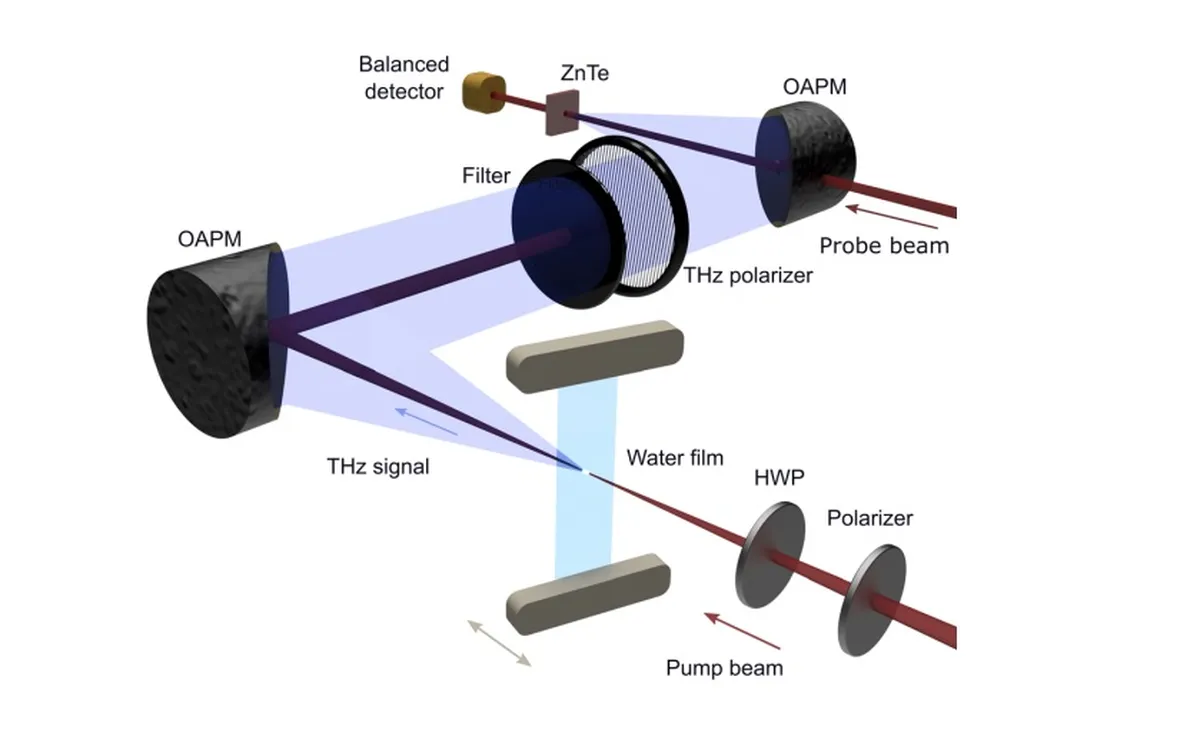

Aside from barriers and subsequent penetration via various techniques developed, the technology itself has been synonymous with Electromagnetic surface waves. meaning that without physical barriers, the curvature of the earth is not a hindrance in that is will skim the surface of the earth along its course, this also attributes to its high efficiency on a base level. Why I mention this is to lead into the area of research it was involved in greatly before the existence of MEMs as we know them today. The DOD has extensive data on its use of EM surface waves minimally as an efficient radar jamming technique, also during that time period, 1960 - 1980, microwave weaponry was integral in naval defense. This likely explains why this technology is so scarcely known or understood. I will be providing both documents regarding military use as sources (16, and 17). Lastly, I will note that tesla had spoken of a wave that can skim the earth as to overcome being dissipated within the curvature. The more tenable comparison to that time period is that of a Zenneck wave, "At high frequencies, a type of surface wave called Zenneck waves can propagate along a surface. They travel better on some materials than others, but performance is best with a conductor covered in a dielectric material. As with wires, these surfaces can carry high bandwidth, are secure, do not cause interference, and require little power. But as with wireless communication, physical contact is not required." (18)
in conclusion, this is an incredibly multifaceted technology of the likes i cannot compare to much anything else. To poke a little further, look up Solaren space energy transmission system. The same philosophies of this Goubau system seem to line up perfectly with the requirements of such a long range transmission to be at all feasible. Food for thought. Enjoy the sources, please inform/ debate if inconsistencies are noticed, or that I’m just plain incorrect in some of my assumptions.
These launchers are not only capable of emitting microwave frequencies for data communications, but also that the system can transmit power wirelessly. These launchers are biconical transceivers that rest physically on powerlines; the propagation of electromagnetic radiation between the launchers emitted from the lines is utilized by a wave guide in which the THz Surface Wave is directed in varying frequencies perpendicularly from the line itself.
Sommerfeld-goubau tech is also a highlight of development in the BIOMEMs field for the past 2 decades due to its ability to transmit frequencies that can pierce the skin, as well as provide power to a receiving antennae as small as 10 micrometers in diameter. It was also found that Facebook line of sight systems work in conjunction with its google counterpart.
Both companies have been developing under the guise of an IOT communications network and have activated every necessary patent since mid 2018 with no attention from the public. 2017 - 2018 being the year of the final patent approvals. Facebooks Line of Sight system can receive the dense wave form emitted by the waveguide attached to Googles Goubau Launchers; once received, it then disperse it in a uniquely precise fashion. Both are capable of ultra low, microwave, up to THZ frequencies depending on ambient conditions and intention of dispersal.
The connection between the 2 systems was originally conceived due to both Googles Launchers and Facebooks Line-of-Sight system having been built by Karthik Yogeeswaran. Karthik has specialized in the transmission of electromagnetic surface waves, microwave communications techniques as well as a most unique tenure in the determination of a devices energy state via wireless detection. The CO-inventor of Facebooks LOS systems, Yael G Miguire, is also the Director Of Engineering at Facebook.
Googles Patent #US10044442B2: "Quasi-wireless communication system" , is described in it's abstract as:
"A method for delivering a communication signal is disclosed. The method includes receiving, at an optical transceiver, an optical communication and constructing, at a baseband integrated circuit in communication with the optical transceiver, a radio frequency communication (e.g., the intermediate frequency data and control signals) based on the optical communication. The method also includes transmitting the radio frequency communication from a Sommerfeld-Goubau launcher in communication with the baseband integrated circuit as a surface wave along a power line to a strand mount device disposed on the power line. The strand mount device is configured to receive the radio frequency communication and wirelessly transmit the radio frequency communication (e.g., via a wireless link) to a user device."
The wave guide allows the propagated EM radiation to be transmitted in ranges up to a terahertz microwave frequency. Sommerfeld Goubau is originally a single wire transmission technology. In the 1950s a gentleman named George Goubau added a waveguide mechanism in between the 2 conical emitters/receivers. Since, it has been close to the chest within the DOD ad government projects. As of late google has found implementations for it. Not only can it transmit wireless energy if met with a line of sight receiver, which Facebook has built, it is capable of x-ray type viewing, interferometry, and a plethora of other uses.
Facebook and Googles' surface wave patents have shared the inventor between them; Karthik Yogeeswaran. Upon investigating how a Goubau wave can produce wireless power, it would need to be met with a line of sight receiver. the patents are put forth under the guise of expediting larger more strenuous data transfer in a precise manner. no doubt it indeed can and will do exactly that, there are many applications for this tech.
Essentially it seems as if the LOS receivers create a perimeter in which they can emit and maintain a central frequency radius. the Domed emitter seems to push out a series of frequencies with much smaller radii that are directed to positions by way of traversing along the curvature of the central emission.
"Various of the disclosed embodiments relate to line-of-sight (LOS), e.g., optical, based networks. Particularly, systems and methods are provided for aligning nodes in a line-of-sight communication network with their peers. The nodes may be placed and passively aligned with one another as position information is passed between peers. The elevation indicated in the position information may be refined based upon relative barometric pressure readings between peers. In a next phase, isolated networks of nodes may be integrated with the network of nodes contacting the Internet backbone. Finally, routing algorithms may be implemented to address weather effects (e.g., fog) and congestion to optimize network service."
" For example, fog 2905 may be impenetrable at optical wavelengths, but not a microwave wavelength. Accordingly, nodes 2910 a and 2910 b may switch to another communication medium (e.g., microwave) until the condition abates."
FACEBOOKS:
#US10044442B2 Quasi-wireless communication system
For Patent information & display see:
Confirmation of Facebooks LOS systems ability to interact with microwave frequencies was found in US20170223605A1: Alignment in Line-Of-Sight Communication Networks citation #0129
"For example, fog 2905 may be impenetrable at optical wavelengths, but not a microwave wavelength. Accordingly, nodes 2910 a and 2910 b may switch to another communication medium (e.g., microwave) until the condition abates."
Confirmation of Facebooks development of wireless power transmission lies in an unsuspecting patent created prior to the development of the LOS systems describing its method power generation from receiving a wireless transmission of THz Microwave frequencies. aptly named:
Generating recommended search queries on online social networks US8949250B1"
which states:
" Antennae 134A-B are components that convert electric current into radio waves, and vice versa. During transmission of signals, a transmitter applies an oscillating radio frequency (RF) electric current to terminals of antenna 134A-B, and antenna 134A-B radiates the energy of the applied the current as electromagnetic (EM) waves. During reception of signals, antennae 134A-B convert the power of an incoming EM into a voltage at the terminals of antennae 134A-B. The voltage may be transmitted to a receiver for amplification."
V.S.
"Wireless Power Transmission Using Magnetic Resonance"
"1.3 INTENDED GOALS Our primary goal was to be able to wirelessly transfer power (in watts) of an AC oscillating waveform into a DC voltage on the receiving end, which could be used to power an electrical load (in watts) to demonstrate instantaneous power transfer. To do this, we intended to design a tunable oscillator capable of generating frequency in the RF band (1MHZ –20 MHz) and a power amplifier to supply enough power to be transmitted for powering the electrical load. In addition to this, we also intended to demonstrate the evanescent waves by the illustration of an exponential relationship of power transmitted to the receiver as a function of distance of separation between the receiver and transmitter coils"
interoperability between facebooks LOS systems and Googles Goubau launchers remains ambiguous by design. however, the fundamentals alone suggest that the 2 are capable of interacting with each other in lieu of communications system in which wireless power can be supplied and transmitted. The few key tells within them are spread thin. Facebook for instance has around 9 patents for the system, each having minor almost unnoticeable differences. this is not a quick read kind of thing.
the CO-inventor however i had not looked into until tonight, Yael G Miguire. Yael G Miguire is the Director Of Engineering at Facebook. His display publication on Yael G Miguires LinkedIn
is:
"Physical Principles for Scalable Neural Recording"
"Simultaneously measuring the activities of all neurons in a mammalian brain at millisecond resolution is a challenge beyond the limits of existing techniques in neuroscience. Entirely new approaches may be required, motivating an analysis of the fundamental physical constraints on the problem. We outline the physical principles governing brain activity mapping using optical, electrical, magnetic resonance, and molecular modalities of neural recording. Focusing on the mouse brain, we analyze the scalability of each method, concentrating on the limitations imposed by spatiotemporal resolution, energy dissipation, and volume displacement. We also study the physics of powering and communicating with micro-scale devices embedded in brain tissue."
regarding Facebooks systems. The perimeter is laid out by 4 transmitters, one on each corner, found in Fig 1. I noticed around my city in populated areas there are square transceivers on the streetlights generally mounted 2 per street corner rotated 90 degrees from each other, picture is linked. I felt that these may be used to create the perimeter in Facebooks System.
square transceivers found here: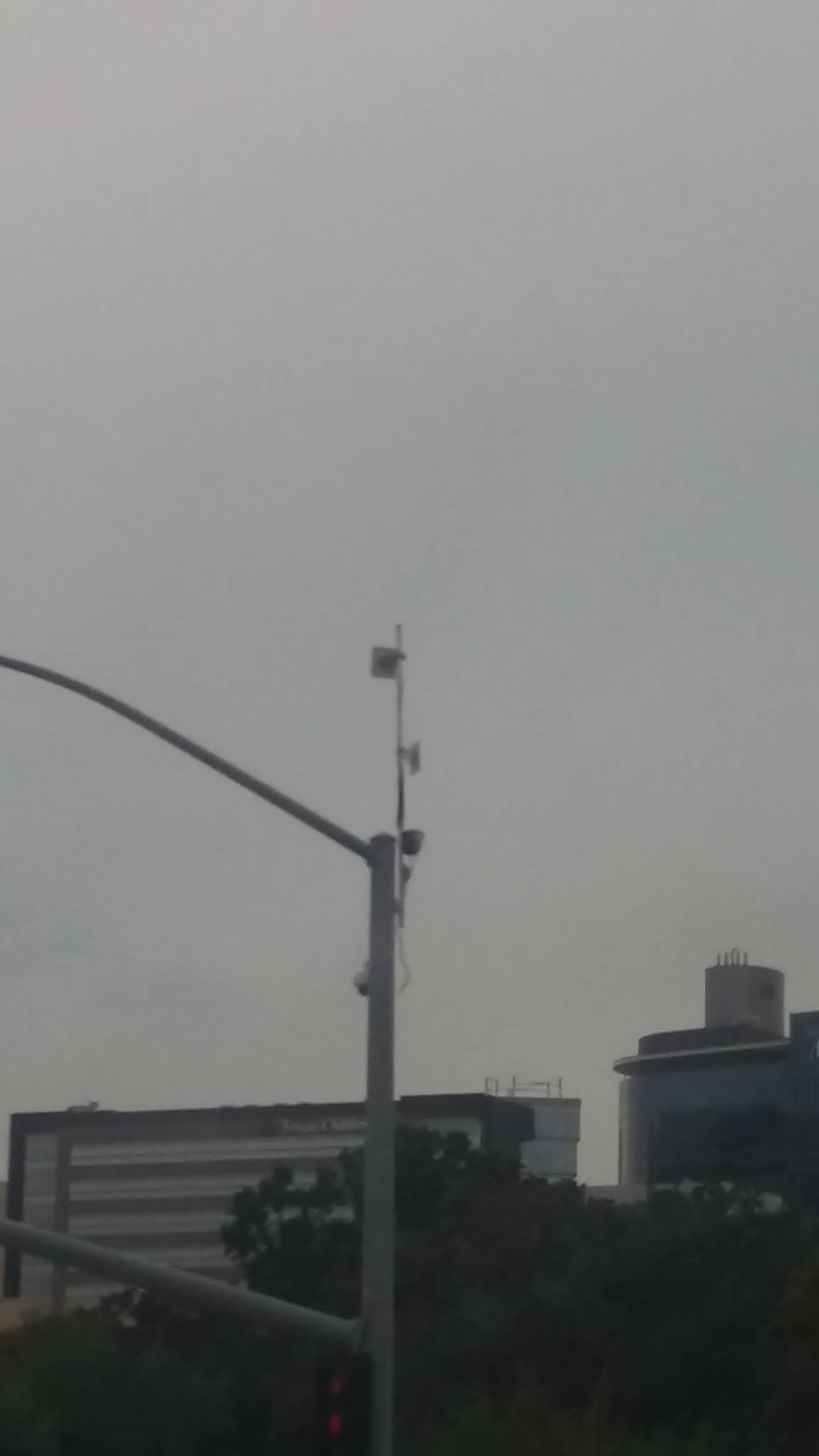

the device had the words OPENWAY on them. i looked up at description, and it turns out this is an itron product, the same company that produced the smart meters. I believe these devices are used to relay streetlight data, camera footage, power grid info, etc. however, Taking into account the company itself, as well as the layout of these devices when compared to the layout of the LOS system, i believe it's reasonable infer that they are one in the same.
OpenWay-Itron PageUpon viewing Yael Maguires facebook resrearch page it was found that these square trancievers, called Terragraph, are indeed the trancievers sought for implimentation by the research project in 2017; "Terragraph is a 60 GHz, multi-node wireless system focused on bringing high-speed internet connectivity to dense urban areas. Utilizing commercial off-the-shelf components and leveraging the cloud for intensive data processing, the Terragraph system is optimized for high-volume, low-cost production."

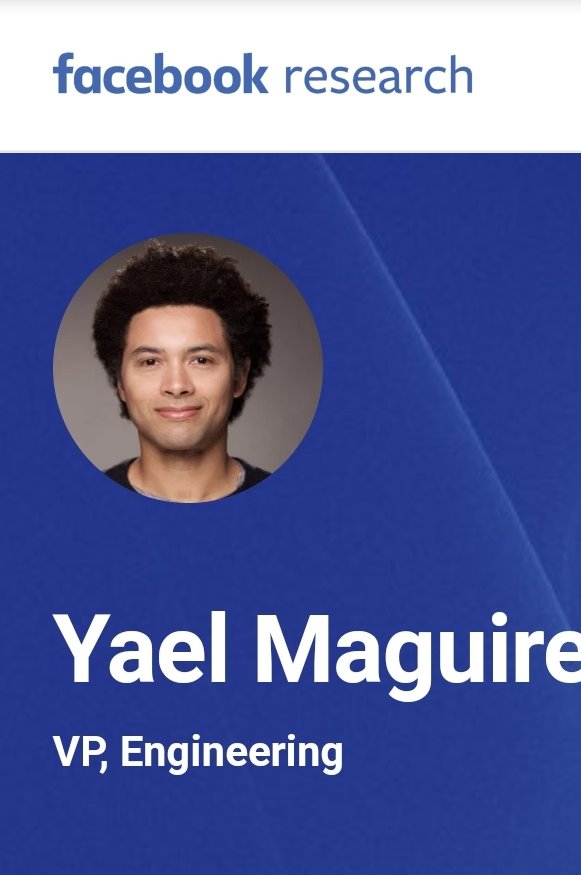
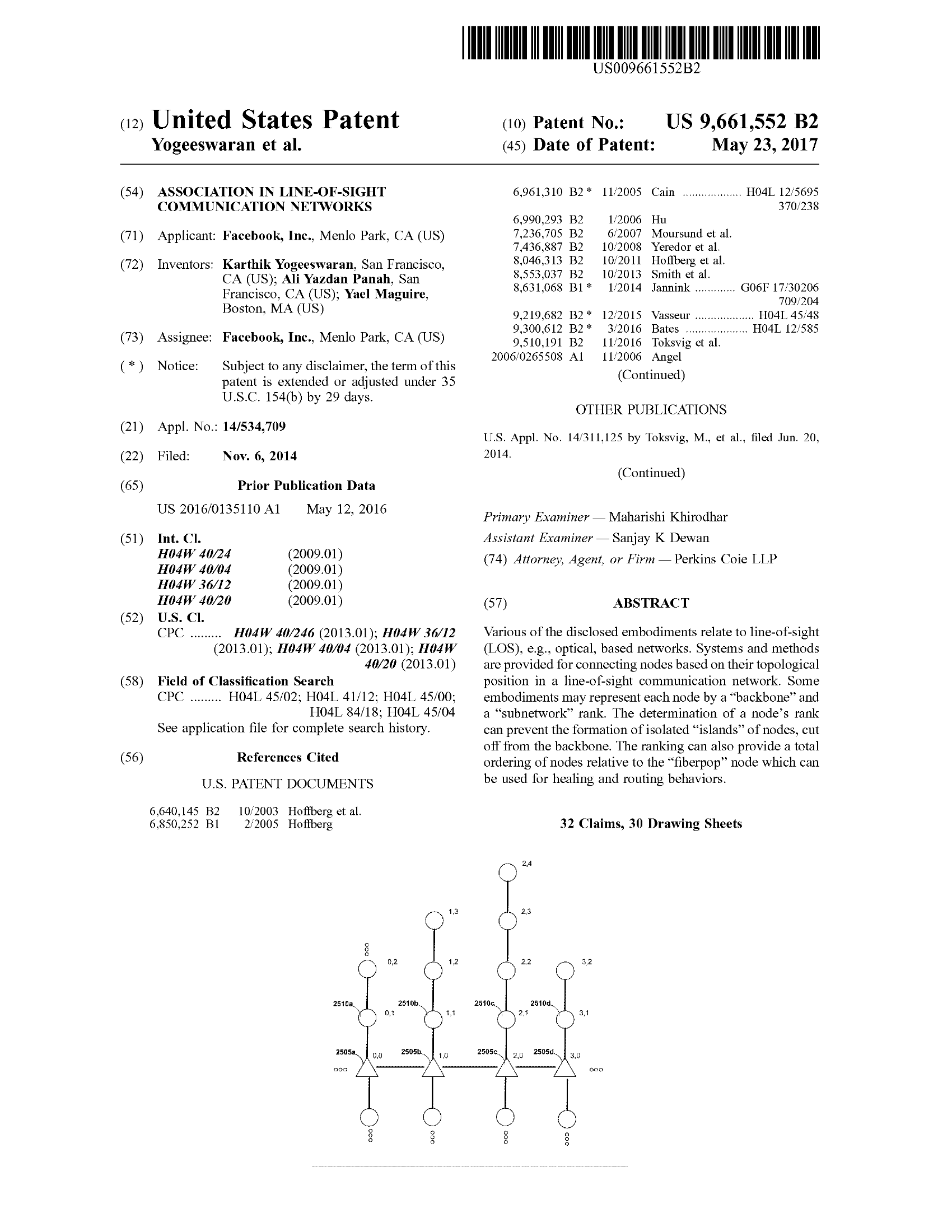

One reason Goubau systems have been developed over the past few decades is because it is ideal for microelectromechanical systems, MEMs, aka. Nanotech as not only can the wave form penetrate the skin it can be received for wireless power on an antenna as small as 10 micrometers. The most prominent names in the BIOMEMs field regarding this tech are Bertrand Bocquet, and Anthony Treizebré. PDF sources will be added in time, the hyperlink is a google search of those names for now.
for military applications and use history see meore here:
DOD surface wave, and microwave documents
Sources
- nginx/1.24.0 (Ubuntu) nginx/1.24.0 (Ubuntu) nginx/1.24.0 (Ubuntu)
- A method for delivering a communication signal is disclosed. The method includes receiving, at an optical transceiver, an optical communication and constructing, at a baseband integrated circuit in communication with the optical transceiver, a radio frequency communication (e.g., the intermediate frequency data and control signals) based on the optical communication. The method also includes transmitting the radio frequency communication from a Sommerfeld-Goubau launcher in communication with the baseband integrated circuit as a surface wave along a power line to a strand mount device disposed on the power line. The strand mount device is configured to receive the radio frequency communication and wirelessly transmit the radio frequency communication (e.g., via a wireless link) to a user device
- nginx/1.24.0 (Ubuntu) nginx/1.24.0 (Ubuntu) nginx/1.24.0 (Ubuntu)
- nginx/1.24.0 (Ubuntu) nginx/1.24.0 (Ubuntu) nginx/1.24.0 (Ubuntu)
- Various of the disclosed embodiments relate to line-of-sight (LOS), e.g., optical, based networks. Particularly, systems and methods are provided for aligning nodes in a line-of-sight communication network with their peers. The nodes may be placed and passively aligned with one another as position information is passed between peers. The elevation indicated in the position information may be refined based upon relative barometric pressure readings between peers. In a next phase, isolated networks of nodes may be integrated with the network of nodes contacting the Internet backbone. Finally, routing algorithms may be implemented to address weather effects (e.g., fog) and congestion to optimize network service
- Various of the disclosed embodiments relate to line-of-sight (LOS), e.g., optical, based networks. Systems and methods are provided for connecting nodes based on their topological position in a line-of-sight communication network. Some embodiments may represent each node by a âbackboneâ and a âsubnetworkâ rank. The determination of a node's rank can prevent the formation of isolated âislandsâ of nodes, cut off from the backbone. The ranking can also provide a total ordering of nodes relative to the âfiberpopâ node which can be used for healing and routing behaviors
- Various of the disclosed embodiments relate to line-of-sight (LOS), e.g., optical, based networks. Particularly, systems and methods are provided for aligning nodes in a line-of-sight communication network with their peers. The nodes may be placed and passively aligned with one another as position information is passed between peers. The elevation indicated in the position information may be refined based upon relative barometric pressure readings between peers. In a next phase, isolated networks of nodes may be integrated with the network of nodes contacting the Internet backbone. Finally, routing algorithms may be implemented to address weather effects (e.g., fog) and congestion to optimize network service
- Various of the disclosed embodiments relate to line-of-sight (LOS), e.g., optical, based networks. Systems and methods are provided for connecting nodes based on their topological position in a line-of-sight communication network. Some embodiments may represent each node by a âbackboneâ and a âsubnetworkâ rank. The determination of a node's rank can prevent the formation of isolated âislandsâ of nodes, cut off from the backbone. The ranking can also provide a total ordering of nodes relative to the âfiberpopâ node which can be used for healing and routing behaviors
- Various of the disclosed embodiments relate to line-of-sight (LOS), e.g., optical, based networks. Systems and methods are provided for connecting nodes based on their topological position in a line-of-sight communication network. Some embodiments may represent each node by a "backbone" and a "subnetwork" rank. The determination of a node's rank can prevent the formation of isolated "islands" of nodes, cut off from the backbone. The ranking can also provide a total ordering of nodes relative to the "fiberpop" node which can be used for healing and routing behaviors
- In one embodiment, a method includes accessing a social graph including a number of nodes and a number of edges connecting the nodes. Each of the edges between two of the nodes represent a single degree of separation between them. The nodes include a first node corresponding to a first user associated with an online social network and a number of second nodes that each correspond to a concept or a second user associated with the online social network. The method also includes generating a number of cards. Each card includes a suggested query referencing a query-domain associated with the online social network and zero or more query-filters for the query-domain. Each query-filter references one or more nodes of the number of nodes or one or more edges of the number of edges
- Various of the disclosed embodiments relate to line-of-sight (LOS), e.g., optical, based networks. Systems and methods for determining where to place and how to configure nodes in an optically connected network across a geographic region are provided. Various factors concerning the region may be collected, including, e.g.,: building locations and height, building types, population densities, backbone connection locations, recurring weather factors, geographic elevation, etc. The algorithm may iteratively place nodes based upon the accessible range of a preceding contemplated node position
- Various of the disclosed embodiments relate to line-of-sight (LOS), e.g., optical, based networks. Systems and methods for determining where to place and how to configure nodes in an optically connected network across a geographic region are provided. Various factors concerning the region may be collected, including, e.g.,: building locations and height, building types, population densities, backbone connection locations, recurring weather factors, geographic elevation, etc. The algorithm may iteratively place nodes based upon the accessible range of a preceding contemplated node position





